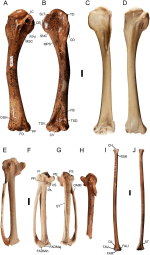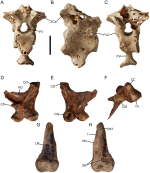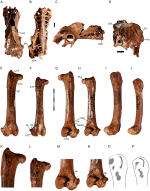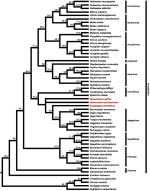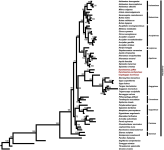Fred Ruhe
Well-known member

Ellen K. Mather, Michael S. Y. Lee, Diana A. Fusco, John Hellstrom, and Trevor H. Worthy, 2023
Pleistocene raptors from cave deposits of South Australia, with a description of
a new species of Dynatoaetus (Accipitridae: Aves): morphology, systematics and
palaeoecological implications
ALCHERINGA: AN AUSTRALASIAN JOURNAL OF PALAEONTOLOGY 1–32. doi:10.1080/03115518.2023.2268780. ISSN 0311-5518
Abstract and free pdf: https://www.tandfonline.com/doi/full/10.1080/03115518.2023.2268780
The Pleistocene fossil record of Australian raptors (Accipitridae: eagles, hawks and Old World vultures) is very poorly understood with only three distinct extinct species confirmed until now. The small Necrastur alacer remains unstudied; however recent research has established Cryptogyps lacertosus as a valid species that, along with the very large Dynatoaetus gaffae, has potential affinities with the Aegypiinae–Circaetinae clade. These, along with a single large living inland raptor, the Wedge-tailed Eagle Aquila audax, suggest that Australia had an impoverished diversity of large raptors compared to other similar continental regions. However, fossil material similar in size to A. audax from multiple Pleistocene cave deposits raises the possibility of further taxa and is here assessed. A partial skeleton from Green Waterhole/Fossil Cave in the Tantanoola District of South Australia is referred to Cryptogyps lacertosus on the basis of similar size to bones of this species and that the associated coracoid is identical to that found with a tarsometatarsus that was previously referred to this species, coming from Leaena’s Breath Cave on the Nullarbor Plain, Western Australia. This partial skeleton allowed additional material from the Old Collections, Wellington Caves, and Walli Caves in New South Wales to be referred to this species. A second species, more robust than A. audax, is identified from material from Victoria Fossil Cave at Naracoorte. Phylogenetic analyses determined this species to be the sister taxon of the much larger Dynatoaetus gaffae recently described from several Australian sites, and so we name it as Dynatoaetus pachyosteus sp. nov. Further fragmentary remains attributable to either A. audax, C. lacertosus or D. pachyosteus are recorded from sites in the Wellington Caves complex, NSW. This study increases the known diversity of raptors in Pleistocene Australia, consistent with the presence of the more diverse megafaunal prey that existed at the time.
Enjoy,
Fred
Pleistocene raptors from cave deposits of South Australia, with a description of
a new species of Dynatoaetus (Accipitridae: Aves): morphology, systematics and
palaeoecological implications
ALCHERINGA: AN AUSTRALASIAN JOURNAL OF PALAEONTOLOGY 1–32. doi:10.1080/03115518.2023.2268780. ISSN 0311-5518
Abstract and free pdf: https://www.tandfonline.com/doi/full/10.1080/03115518.2023.2268780
The Pleistocene fossil record of Australian raptors (Accipitridae: eagles, hawks and Old World vultures) is very poorly understood with only three distinct extinct species confirmed until now. The small Necrastur alacer remains unstudied; however recent research has established Cryptogyps lacertosus as a valid species that, along with the very large Dynatoaetus gaffae, has potential affinities with the Aegypiinae–Circaetinae clade. These, along with a single large living inland raptor, the Wedge-tailed Eagle Aquila audax, suggest that Australia had an impoverished diversity of large raptors compared to other similar continental regions. However, fossil material similar in size to A. audax from multiple Pleistocene cave deposits raises the possibility of further taxa and is here assessed. A partial skeleton from Green Waterhole/Fossil Cave in the Tantanoola District of South Australia is referred to Cryptogyps lacertosus on the basis of similar size to bones of this species and that the associated coracoid is identical to that found with a tarsometatarsus that was previously referred to this species, coming from Leaena’s Breath Cave on the Nullarbor Plain, Western Australia. This partial skeleton allowed additional material from the Old Collections, Wellington Caves, and Walli Caves in New South Wales to be referred to this species. A second species, more robust than A. audax, is identified from material from Victoria Fossil Cave at Naracoorte. Phylogenetic analyses determined this species to be the sister taxon of the much larger Dynatoaetus gaffae recently described from several Australian sites, and so we name it as Dynatoaetus pachyosteus sp. nov. Further fragmentary remains attributable to either A. audax, C. lacertosus or D. pachyosteus are recorded from sites in the Wellington Caves complex, NSW. This study increases the known diversity of raptors in Pleistocene Australia, consistent with the presence of the more diverse megafaunal prey that existed at the time.
Enjoy,
Fred




